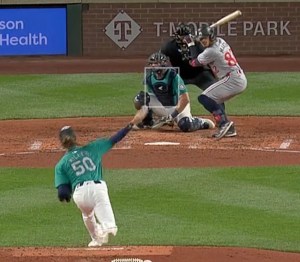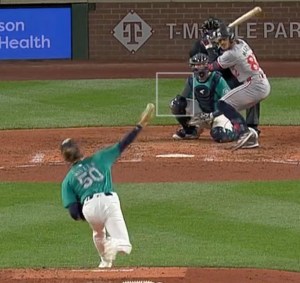Full disclosure, I have been known to project potential in pitchers where it probably didn’t actually exist. Maybe I’m an optimist, but I think there are a lot of ways for pitchers to find success, and I can frequently find hope even when a pitcher is getting pieced up time and time again. I don’t think this is a case where I’ll need to do much convincing. The future you can envision when watching Bryce Miller on the mound is by no means a stretch. His abilities and skills are pretty apparent to anyone watching. So why hasn’t he taken the next step? He showed a lot of promise in his rookie season, and while his ERA has improved, his underlying metrics are still a bit shaky.
This is very precedented for a second-year pitcher. He was drafted in 2021, meaning this is only his third full season as a professional. He’s still learning who he is as a pitcher, but he’s doing it at the highest level. This is bound to come with some growing pains. What Miller does better than most though, is what got him fast-tracked to MLB. He has a phenomenal arsenal of pitches. One of the best in the sport. Before we get to what he needs to be doing differently, let’s cover what he has to offer.
Miller’s arsenal revolves around his excellent four-seam fastball. Well above average rise from a lower than average release. This is the default pitch people think of when picturing good pitching in a general sense. This is pure gas. A pitch that will frequently rise above bats that aren’t waiting for it specifically. Even then it probably still can.
Miller’s sinker is an attempt to give him a pitch to manage contact with. It plays well off of his fastball which is why it works despite having an unimpressive shape in a vacuum. Baseball has seen a recent revolution of sinkers with mediocre shapes performing well due to their fit in the arsenal, and this fits that category.
Miller’s splitter is a new addition to his arsenal and is potentially already the best pitch in his arsenal. A pure drop-ball of an off-speed pitch, it falls off the table with tremendous depth. It drops so much that it’s largely held up against contact. Hitters aren’t doing anything with it when they put it in play, which isn’t common for off-speed pitches.
Miller’s sweeper has so much depth to it that I’d put it in slurve territory. There’s a negative connotation to slurves but I think that comes more from pitches with bad curveball shapes getting labeled “slurvy” when they are, as previously mentioned, just bad curveballs. Despite all the movement Miller gets with this pitch, it has been awful for him. This is due to what I’m diagnosing as a mix of bad luck on batted balls, and poor locations that don’t lead to whiffs. The pitch is fine in theory, he needs to use it better.
Miller’s slider was his primary non-fastball last season but has taken a back seat this year. If this is a stylistic choice, it is wrong. This is his best breaking ball, with power and tight gyro-heavy movement. If this is a choice being made due to the pitch causing him arm pain like his teammate Bryan Woo, it’s as unfortunate as it is necessary.
Miller’s cutter is a new, experimental pitch that he’s only used a handful of times. Its shape is unique but probably not in a good way right now but if he can get more depth to it I’m interested. Pitchers that can use a 4-seam/sinker/cutter combination well tend to play above their stuff regardless of how good it is.
The Issues
Like most young pitchers, Miller’s arsenal is not being used to its potential. He’s run into some problems finishing batters off, potentially due to predictability. He loves to go to the fastball and splitter with two strikes, but those pitches are so distinct from each other that there’s not a ton of deception to be had. This leaves them relying entirely on their stuff to get the outs. They’re good pitches, but he’s not doing himself any favors like this. He needs to gain confidence in his other pitches, especially his slider if it’s not bothering his arm.
Furthermore, his sinker can be more than what he’s using it as, especially at the rate he’s using it. He aims almost entirely for called strikes when he could be running it in on right-handed hitters. This would open up his fastball for more whiffs above the zone while also making better use of the pitch. It’s fine as a called-strike pitch, but there’s more in the tank for it. George Kirby basically lives off of this combo, so there’s an excellent and very nearby example for Bryce for what he could be doing. I’m not saying he’s going to magically gain Kirby’s generational fastball command, but he could borrow the strategy.
We’ll be getting into something speculative now, so take this next bit with a grain of salt. Miller may be tipping his fastball with his arm slot. He releases the ball at a higher angle with his fastball than any of his other pitches. It’s not a huge margin but it doesn’t necessarily need to be. Josiah Gray went from giving up the most home runs in the entire league in 2022 to being an all-star in 2023 after working on a similar issue. Miller’s isn’t as extreme a difference but it’s just barely enough that it makes me wonder.


This is the most recent instance of back-to-back fastball and splitter from the same at-bat for Miller, with the splitter on the top, and the fastball on the bottom. The arm slot is slightly different and his shoulders are further tilted toward the glove side for the fastball. It’s subtle at full speed but major league hitters are freaks of nature who can pick up on the slightest of things whether they realize they’re doing it or not. I will never underestimate their Holmesian detective skills.
Of course, in the interest of presenting both sides of an argument, it’s worth mentioning that these two pitches that are the furthest apart are the only two he has that get chases at an average or better rate, though that may be a product of using them in so many two-strike counts and their excellent stuff. I even said earlier that the fastball and splitter probably lack deception off of each other. Different spin directions, different arm-slots, wildly different spin rates, the ways that we can quantify deception, he doesn’t check any of those boxes with those two. Yet they get chases. He locates them well, combined with their stuff and when he uses them out of the zone, this could explain the chase rates despite the lack of deception. This both confuses and impresses me. That’s baseball, I guess.
After that, all that’s left is to execute better. Learn to throw the sweeper outside of the zone. It’s not a bad pitch, but the inability to throw it where he wants when it’s not in the zone is holding it back. If he’s going to challenge with his sinker, do so in less hittable spots. Make sure the four-seam isn’t slipping too low. Basic stuff you could say about a lot of pitchers if I’m being honest.
The Outlook
There are some things that Miller will always struggle with. Such is the nature of baseball, the perfect do-it-all player simply doesn’t exist in today’s game at any position. There’s always a catch, or at least something they’re just average at. Miller’s destined battle is against giving up extra-base hits. As a rising fastball pitcher, this is unavoidable. His other pitches give him the hope of being able to manage some contact, while his zone-filling should keep him from giving out too many free passes. Hopefully, the barrels he gives up will come with the bases empty.
Miller is a gifted pitcher, with a bevy of excellent pitches at his disposal. He just needs to work on how he’s using them. He’s got plenty of time for that, and for a guy who’s been doing it with a trial by fire, commendations are deserved for how well he’s fared. Maybe I’m holding him to too high of a standard if I’m finding myself frustrated with him. He’s had good results, I just can’t help but envision the pitcher he could be. It’s not an unrealistic vision, the improvements to be made are all very doable. He’s already shown an ability to make adjustments as needed to his way of doing things, which gives me hope he’ll be able to keep developing into the pitcher we all know he can be.

As a Mariners fan, I love watching Bryce Miller and want him to succeed, but right now in Fantasy I’m starting Bryce Miller in home starts, but not road starts.
At home: 54.1 IP, 65 K, 1.99 ERA
https://www.mlb.com/stats/pitching?split=h&sortState=asc
On the Road: 43 IP, 26 K, 6.28 ERA
https://www.mlb.com/stats/pitching?split=a
When ranking players overall (not in fantasy purposes), I like to consider who is a better player overall on their road stats. Obviously this doesn’t apply to fantasy baseball or IRL since we know a player is gonna play half their games at home. As you’ve probably got more resources available to you than I do, I’d be interested in hearing a deeper dive on this subject.